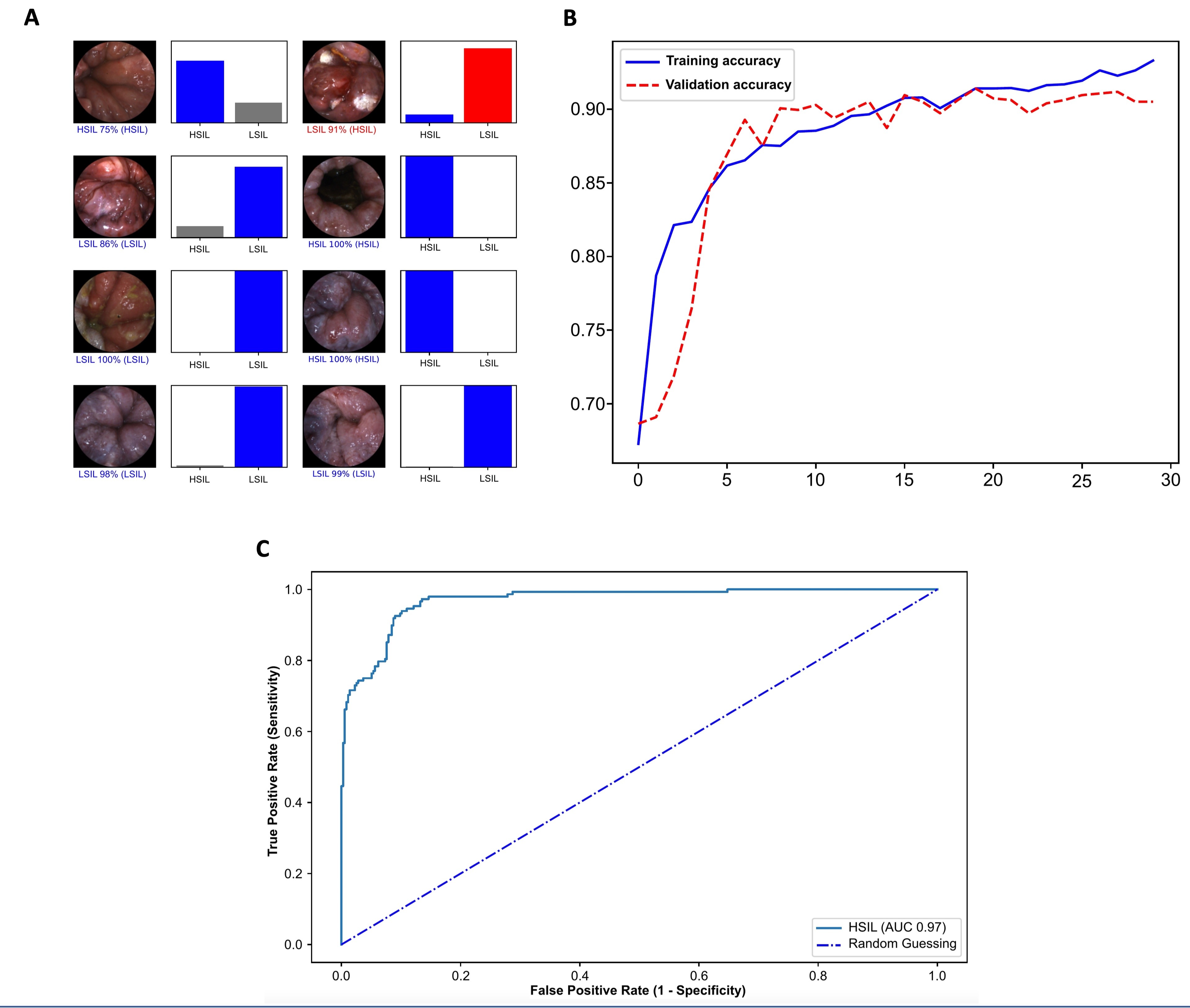Back
Oral Paper Presentation
Annual Scientific Meeting
Session: Plenary Session 4A - Colon / IBD
57 - Artificial Intelligence and High-Resolution Anoscopy: Automatic Identification of Anal Squamous Cell Carcinoma Precursors Using a Convolutional Neural Network
Wednesday, October 26, 2022
8:50 AM – 9:00 AM ET
Location: Hall C2

Miguel Mascarenhas, MD
Centro Hospitalar de S. João
Porto, Porto, Portugal
Presenting Author(s)
Award: ACG Auxiliary Award (Trainee)
Miguel Mascarenhas, MD1, Lucas Spindler, MD2, Nadia Fathallah, MD2, Tiago Ribeiro, MD1, Joao Afonso, MD3, João Ferreira, PhD4, Guilherme Macedo, MD, PhD1, Vincent De Parades, MD, PhD2
1Centro Hospitalar de S. João, Porto, Porto, Portugal; 2Hospital Paris Saint Joseph, Paris, Ile-de-France, France; 3Centro Hospitalar de São João, Porto, Porto, Portugal; 4FEUP: Faculdade de Engenharia da Universidade do Porto, Porto, Porto, Portugal
Introduction: High-resolution anoscopy (HRA) is the gold standard for detecting anal squamous cell cancer (ASCC) precursors.
Although it is superior to other diagnostic methods, particularly cytology, the visual identification of areas suspected of having high-grade squamous intraepithelial lesions (HSIL) remains challenging. Deep learning models, namely convolutional neural networks (CNNs), excel in image analysis and have shown great potential for assessing pleomorphic endoscopic images. Our group aimed to develop a CNN-based system for automatically detecting and differentiating HSIL versus LSIL (low-grade squamous intraepithelial lesion) in HRA images.
Methods: A convolutional neural network was developed based on 78 HRA exams from 71 patients from a Proctology high-volume
center (GH Paris Saint-Joseph, Paris, France). A total of 5,026 images were included, 1,517 images containing HSIL and 3,509 LSIL. A training dataset comprising 90% of the total pool of images was defined to develop the network. The performance of the CNN was evaluated using an independent testing dataset comprising the remaining 10%. The sensitivity, specificity, accuracy, positive and negative predictive values, and area under the curve (AUC) were calculated.
Results: The algorithm was optimized for the automatic detection of HSIL and its differentiation from LSIL. Our model had an overall accuracy of 92.3%. The CNN had a sensitivity, specificity, and positive and negative predictive values of 91.4%, 92.7%, 86.9%, and 95.9%, respectively. The area under the curve was 0.97.
Discussion: Our group developed the first worldwide AI model for HRA. The CNN model accurately detected and differentiated
precursors of squamous anal cancer. Further development and implementation of these tools in clinical practice may significantly
modify the management of these patients and the current state of the art in HRA.

Disclosures:
Miguel Mascarenhas, MD1, Lucas Spindler, MD2, Nadia Fathallah, MD2, Tiago Ribeiro, MD1, Joao Afonso, MD3, João Ferreira, PhD4, Guilherme Macedo, MD, PhD1, Vincent De Parades, MD, PhD2, 57, Artificial Intelligence and High-Resolution Anoscopy: Automatic Identification of Anal Squamous Cell Carcinoma Precursors Using a Convolutional Neural Network, ACG 2022 Annual Scientific Meeting Abstracts. Charlotte, NC: American College of Gastroenterology.
Miguel Mascarenhas, MD1, Lucas Spindler, MD2, Nadia Fathallah, MD2, Tiago Ribeiro, MD1, Joao Afonso, MD3, João Ferreira, PhD4, Guilherme Macedo, MD, PhD1, Vincent De Parades, MD, PhD2
1Centro Hospitalar de S. João, Porto, Porto, Portugal; 2Hospital Paris Saint Joseph, Paris, Ile-de-France, France; 3Centro Hospitalar de São João, Porto, Porto, Portugal; 4FEUP: Faculdade de Engenharia da Universidade do Porto, Porto, Porto, Portugal
Introduction: High-resolution anoscopy (HRA) is the gold standard for detecting anal squamous cell cancer (ASCC) precursors.
Although it is superior to other diagnostic methods, particularly cytology, the visual identification of areas suspected of having high-grade squamous intraepithelial lesions (HSIL) remains challenging. Deep learning models, namely convolutional neural networks (CNNs), excel in image analysis and have shown great potential for assessing pleomorphic endoscopic images. Our group aimed to develop a CNN-based system for automatically detecting and differentiating HSIL versus LSIL (low-grade squamous intraepithelial lesion) in HRA images.
Methods: A convolutional neural network was developed based on 78 HRA exams from 71 patients from a Proctology high-volume
center (GH Paris Saint-Joseph, Paris, France). A total of 5,026 images were included, 1,517 images containing HSIL and 3,509 LSIL. A training dataset comprising 90% of the total pool of images was defined to develop the network. The performance of the CNN was evaluated using an independent testing dataset comprising the remaining 10%. The sensitivity, specificity, accuracy, positive and negative predictive values, and area under the curve (AUC) were calculated.
Results: The algorithm was optimized for the automatic detection of HSIL and its differentiation from LSIL. Our model had an overall accuracy of 92.3%. The CNN had a sensitivity, specificity, and positive and negative predictive values of 91.4%, 92.7%, 86.9%, and 95.9%, respectively. The area under the curve was 0.97.
Discussion: Our group developed the first worldwide AI model for HRA. The CNN model accurately detected and differentiated
precursors of squamous anal cancer. Further development and implementation of these tools in clinical practice may significantly
modify the management of these patients and the current state of the art in HRA.

Figure: Fig. 1 1A - Output obtained after running the convolutional neural network. The percentage represents the estimated probability calculated by the algorithm. A blue bar represents a correct prediction by the convolutional neural network. Red bars represent misclassifications by the network. HSIL – high-grade squamous intraepithelial lesion; LSIL - low-grade squamous intraepithelial lesion. 1B - Evolution of the accuracy of the convolutional neural network during training and validation phases, as the training and validation datasets were repeatedly inputted in the neural network. 1C - ROC analysis of the network’s performance in the detection of HSIL versus LSIL. HSIL – high-grade squamous intraepithelial lesion; LSIL - low-grade squamous intraepithelial lesion; ROC – receiver operator characteristics.
Disclosures:
Miguel Mascarenhas indicated no relevant financial relationships.
Lucas Spindler: THD – Endorsement of the publication of the Atlas of Proctology and annual Proctology meeting.
Nadia Fathallah: THD – Endorsement of the publication of the Atlas of Proctology and annual Proctology meeting.
Tiago Ribeiro indicated no relevant financial relationships.
Joao Afonso indicated no relevant financial relationships.
João Ferreira indicated no relevant financial relationships.
Guilherme Macedo indicated no relevant financial relationships.
Vincent De Parades: THD – Endorsement of the publication of the Atlas of Proctology and annual Proctology meeting.
Miguel Mascarenhas, MD1, Lucas Spindler, MD2, Nadia Fathallah, MD2, Tiago Ribeiro, MD1, Joao Afonso, MD3, João Ferreira, PhD4, Guilherme Macedo, MD, PhD1, Vincent De Parades, MD, PhD2, 57, Artificial Intelligence and High-Resolution Anoscopy: Automatic Identification of Anal Squamous Cell Carcinoma Precursors Using a Convolutional Neural Network, ACG 2022 Annual Scientific Meeting Abstracts. Charlotte, NC: American College of Gastroenterology.


